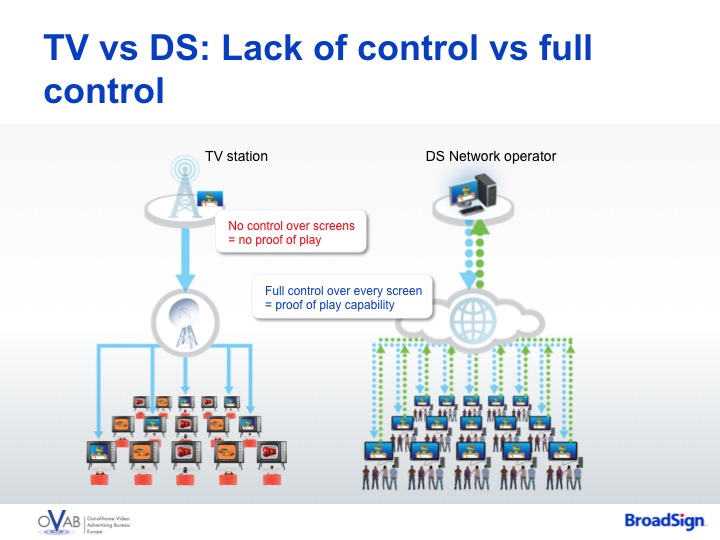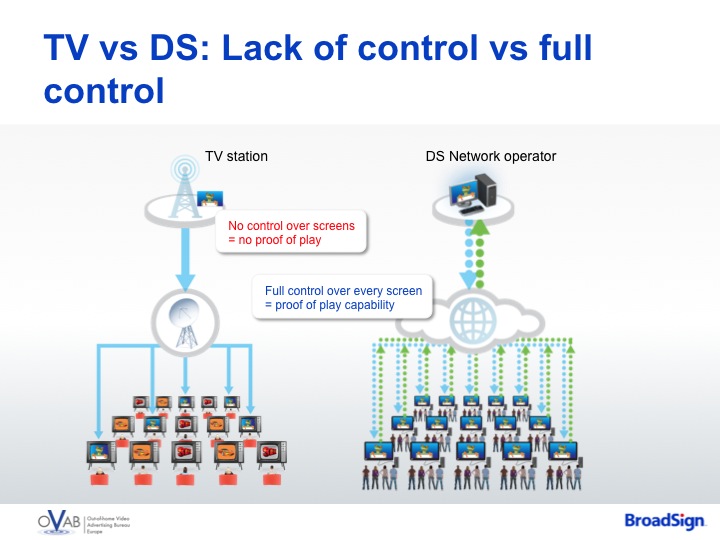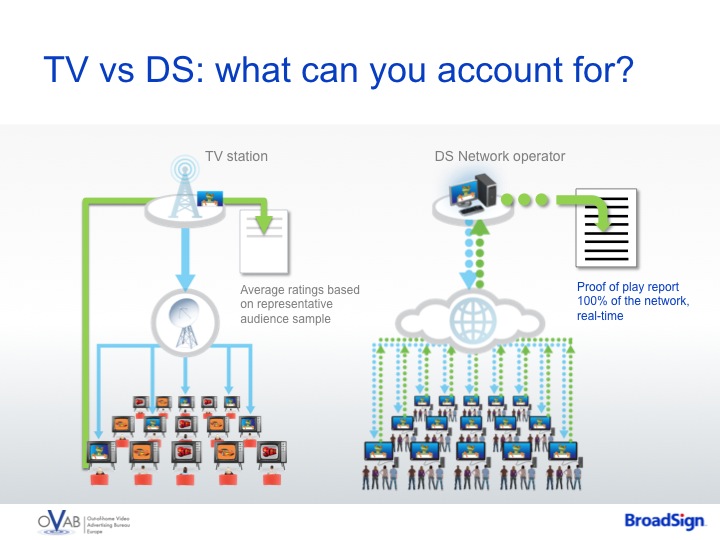Proof-of-play – an Irrefutable Pillar of Accountability for Digital Signage (Digital Out-of-Home) Advertising

- By Nurlan Urazbaev and Daniel Parisien
Introduction: Proof-of-play’s Role in DS/DOOH Advertising

In recent years Digital Signage (DS) aka Digital Out-of-Home (DOOH) medium has proven beyond any doubt that it is the most effective way of reaching consumers on-the-go. Numerous studies show ad recall, retention, purchase intent and actual sales lift numbers that are higher than any other media deliver. DS can be used on its own or in combination with other types of advertising.
Leading industry organizations are making steady progress in raising awareness of DS among advertisers, promoting best practices and establishing metrics.
At the same time, despite growing faster than other media, DS remains a relatively small segment, without an identity of its own or tools to facilitate media buys. For DS to start to seriously compete for big advertising budgets, several things must happen in the field of accountability standards. Advertisers should have a clear understanding of how to buy DS ad space and how to determine if the buy was successful or not.
DPAA (formerly OVAB) has developed Audience Metrics Guidelines that help calculate impressions per ad play, trying to bring DS to a common denominator with TV and Radio. While still being an important benchmark to most agencies who are used to buying media by ‘eyeball’ count (CPMs or GRPs), impressions-based metrics appear to be a tribute to the TV-dominated past, a legacy that does not reflect the power of new media.
Why It is not Beneficial for DS to be Compared to TV
‘Impressions’ measurement stems from the inherent limitation of TV: since broadcasters cannot control the screens, TV has had no other way of accounting for advertising than trying to figure out whether or how many people watched the commercials. As there was no direct way of determining that, the industry settled for programme ratings and its latest incarnation - C3 ratings – which is focusing on average commercial minutes viewed.

In TV, once the signal is transmitted from the tower or via cable, it is difficult to capture which TV set is on, which program is showing and who is watching it. DS, by nature, has the ability to control each screen at any time, even if every screen in a thousand is scheduled to show its unique programming. In other words, when it comes to proof-of-play, DS can potentially surpass any other media, because reports can be generated in real time, across the whole network, and be queried by campaign, time frame, network segments or in many other ways.
A daily selection of the top stories for AV integrators, resellers and consultants. Sign up below.
Why then are there very few software applications that are able to produce accurate, reliable, real-time proof-of-play reports? The answer lies in the fact that the very capability of pinpoint targeting and controlling every screen presents a computational challenge for reporting. Many software applications were initially focused on other aspects of DS (such as content creation, screen layout, dynamic content, ad triggers, etc.), and not on scalability and reporting. Building a precision proof-of-play system requires a dedicated development assignment.
Three Tiers of Accountability
A few years ago BroadSign introduced the concept of three tiers of accountability in digital signage:
Tier 1: proof of ad delivery (proof of play reports)
Tier 2: proof of audience delivery
Tier 3: proof of ad effectiveness

In the absence of Tier 2, Tier 1 can still work with Tier 3. In the absence of Tier 3, Tier 1 and Tier 2 can still provide a significant level of accountability. However, without Tier 1 proof of ad audience and proof of ad effectiveness alone are not sufficient for a satisfactory post-buy analysis
Another critical advantage of having a reliable proof of play reporting is the fact that, when in place, it provides a much more reliable basis for justifying network ad rates than impressions. The benefit of pricing one’s ad space based on proof of play is that in this case the network owners take the responsibility for what they can account for: proven ad delivery; whereas the responsibility for catching the audience’s attention with an ad is then transferred back to the advertiser, which is a more natural division of duties.
Based on the above arguments, it becomes apparent that proof-of-play is the foundation of accountability in digital signage/DOOH.
What Criteria Should Proof-of-Play Meet to Satisfy the Advertiser?
In order to take maximum advantage of proof-of-play, networks need to put in place four components of a properly accountable digital signage reporting system:
1. Provide Proof of Display
Proof of play is the term used in digital signage to describe the summary playback reports and the raw play logs. Proof of play is the equivalent of tearsheets in newspapers and of online exposures served to a web page. While it seems obvious that proof of play should report on which ads were actually displayed on each screen and when, most of these reports only register which content was played by the playback device at best, not on the screens connected to it. If one or more of the screens are off or disconnected from the player, the proof of play would not detect that in many cases. This leads to the wrong count of ad plays, distorted count of impressions and the wrong conclusions in the post-campaign analysis. So by saying ‘provide Proof of Display versus proof of play’ we want to stress the importance of reporting of what really matters: playback at the screen level.
2. Audited Play Logs
Most digital signage playback devices produce raw play logs that track what ad played, the date and time when it played and the duration of time it has played. In order to validate the accuracy of the entire reporting system for advertisers, it is a good practice for these play logs to be audited by a third party. Such audits independently register what is being played on the actual screen and then the results are compared to the play logs.
3. The Campaign Plan Report
The purpose of the campaign plan is to be able to provide a measurable commitment to the media buyer before they sign the ad contract. Using the characteristics of the network, one can generate a forward-looking plan that estimates how many times the ad will play in each targeted location. Having a Campaign Plan report with planned ad plays numbers will make it easier for networks to justify the initial billing estimates.
4. The Campaign Performance Report
The campaign performance report aggregates the raw play logs for that campaign and presents the total results of the campaign against the “promise” made in the campaign plan report. The comparison between the planned plays and the achieved plays is how performance is calculated. Such campaign performance reports constitute a solid basis for invoicing the media buy, make-goods or invoice reconciliation.

Based on our experience, the vast majority of digital signage networks do not have even two out of the four of the above components of a fully accountable digital signage reporting system.
Some networks charge a flat fee for a week-long, a month-long, three month-long, etc., campaign flight, based on roughly estimated “impressions”, without providing any proof of play (or providing just a sworn affidavit). Since the ways the impressions are calculated vary from network to network, such campaign cost estimates (and CPM values) are highly questionable. This ambiguity does not contribute to building the credibility of DS.
Some networks provide a proof of play report, or play logs. As mentioned earlier, most of the play logs, however, only report the fact that the player was on when the ad was supposed to play, not what actually played on the screens.
What should be Reported to Advertisers?
Upon getting massive feedback from the ad community, the following proof-of-play reporting structure appears to be working best:
1. Campaign plan – forecasted number of ad plays (broken down to individual screens, location, market, etc.) – is delivered to advertisers prior to campaign, along with the billing estimate.
2. Acurate, 3rd-party-auditable raw proof of play logs at the screen level (proof of display)
3. Campaign performance report – can be generated at any moment of campaign (for monitoring purposes) and at the end of the campaign. The most convenient format is an affidavit-type summary that lists planned ad plays versus achieved. Detailed raw logs should be either appended or provided upon request for closer scrutiny, if needed.
4. Proof-of-play report summary (Affidavit) – provides a simplified view summarizing the ad plays achieved and basic parameters of the campaign.
